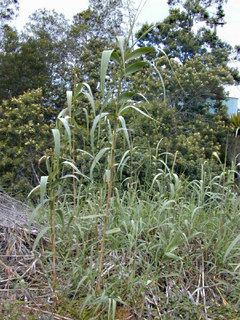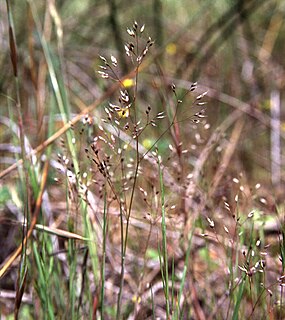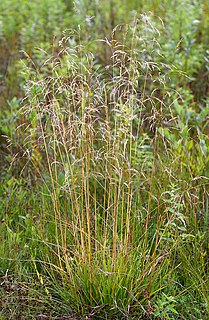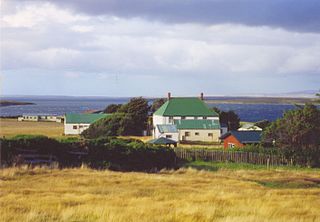
Arundo is a genus of stout, perennial plants in the grass family.

Aira is a genus of Old World plants in the grass family, native to western and southern Europe, central and southwest Asia, plus Africa.

Deschampsia cespitosa, commonly known as tufted hairgrass or tussock grass, is a perennial tufted plant in the grass family Poaceae. Distribution of this species is widespread including the eastern and western coasts of North America, parts of South America, Eurasia and Australia.

Deschampsia is a genus of plants in the grass family, commonly known as hair grass or tussock grass. The genus is widespread across many countries.

Triodia is a large genus of hummock-forming bunchgrass endemic to Australia. They are known by the common name spinifex, although they are not a part of the coastal genus Spinifex. Many of the soft-leaved members of this species were formerly included in the genus Plectrachne.

Hakea petiolaris, commonly known as the sea-urchin hakea, is a shrub or small tree with cream-coloured and pink or purple flowers and woody fruit. It is endemic to the south west of Australia, occurring at the coastal plain, jarrah forest and wheatbelt regions, often at the ancient granite outcrops of Western Australia.
British NVC community MG9 is one of the mesotrophic grassland communities in the British National Vegetation Classification system. It is one of three communities associated with poorly drained permanent pastures.
Deschampsia robusta is a species of grass in the family Poaceae. It is found on Gough Island, near Tristan da Cunha in the South Atlantic Ocean.
Deschampsia wacei is a species of grass in the family Poaceae. It is found in Tristan da Cunha in the South Atlantic. Its natural habitat is swamps.

Deschampsia flexuosa, commonly known as wavy hair-grass, is a species of bunchgrass in the grass family widely distributed in Eurasia, Africa, South America, and North America.

Tussock grasses or bunch grasses are a group of grass species in the family Poaceae. They usually grow as singular plants in clumps, tufts, hummocks, or bunches, rather than forming a sod or lawn, in meadows, grasslands, and prairies. As perennial plants, most species live more than one season. Tussock grasses are often found as forage in pastures and ornamental grasses in gardens.

Deschampsia danthonioides is a species of grass known by the common name annual hairgrass. It is native to western North America from the Yukon Territory and British Columbia, through California and the Western United States, to Baja California, and also to southern South America in Chile and Argentina.

The Cuban slider is a species of turtle native to Cuba, but has also been introduced to Grand Cayman and Cayman Brac in the Cayman Islands (where it is known as the taco river slider or hickatee, and Marie Galante in Guadeloupe.

Colpodella is a genus of alveolates comprising 5 species, and two further possible species: They share all the synapomorphies of apicomplexans, but are free-living, rather than parasitic. Many members of this genus were previously assigned to a different genus - Spiromonas.

Phalaris angusta is a species of grass known by the common names timothy canarygrass and narrow canarygrass. It is native to the Americas, where it is most common in Chile and Argentina and can be found in northern South America and sections of the southwestern and southeastern United States. It is also known as an introduced species in Australia. It grows in grassland, prairie, marshland, and other habitat.

Elachista albidella is a moth of the family Elachistidae, described by William Nylander in 1848. Its wingspan ranges from 9–10 millimetres (0.35–0.39 in).The head is white. Forewings are white, costa and sometimes dorsum suffused with fuscous; plical stigma large, elongate, black ; an angulated fuscous fascia beyond middle, angle acutely produced towards apex ; small fuscous costal and dorsal spots near apex. Hindwings are rather dark grey.The larva is greenish-grey, more yellowish anteriorly; head dark brown.

Fissurella angusta is a species of sea snail, a marine gastropod mollusk in the family Fissurellidae, the keyhole limpets.
Koloonella is a genus of sea snails, marine gastropod mollusks in the family Murchisonellidae, the pyrams and their allies.

Helastia angusta is a moth of the family Geometridae. This species is endemic to New Zealand. It is classified as "At Risk, Relict'" by the Department of Conservation.















